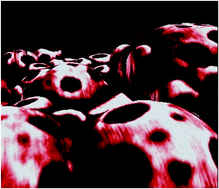In this study, Crespy and co-workers developed an easy, low-cost and mild strategy to fabricate PPs in large quantities without using block copolymers. Polymerization-induced phase separation was found to be the reason for the formation of the PPs. The size of the patches could be easily tuned by controlling the monomer conversion or by changing the composition of the nanoparticles. The atomic force microscopy analysis revealed that the patches were sticky and embedded in a harder polymer matrix. Moreover, the patchy structure could be locked by cross-linking the sticky patches. Their approach could be extended to prepare large libraries of different PPs by choosing other polymer/monomer pairs and/or by post-functionalizing the patchy area.
Polymer patchy colloids with sticky patches by Yi Zhao, Rüdiger Berger, Katharina Landfester and Daniel Crespy Polym. Chem. 2014, 5, 365-371.
Julien Nicolas is a web-writer and advisory board member for Polymer Chemistry. He currently works at Univ. Paris-Sud (FR) as a CNRS researcher.











